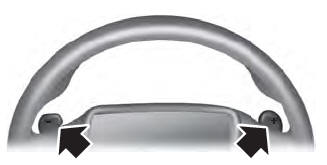Lincoln Aviator: Transmission / SelectShift Automatic™ Transmission
Your vehicle has a SelectShift Automatic transmission. The SelectShift Automatic transmission gives you the ability to change gears up or down, without a clutch, as preferred.
To prevent the engine from running at too low an RPM, which could cause it to stall, SelectShift still makes some downshifts if it determines that you have not downshifted in time. Although SelectShift makes some downshifts for you, it still allows you to downshift at any time if the SelectShift determines that damage to the engine from over-revving cannot occur.
Note: Engine damage could occur if you maintain excessive engine revving without shifting.
Note: Vehicles have either steering wheel controls or gearshift lever controls.
SelectShift could upshift if the engine is approaching the RPM limit. It can also be upshifted manually by pressing the (+) button.
Pull the + paddle on the steering wheel or push the + button on the gearshift lever to activate SelectShift.
- Pull the right paddle (+) to upshift.
- Pull the left paddle (–) to downshift.

SelectShift in drive (D):
- Provides a temporary manual mode for performing more demanding maneuvers where you require extra control of gear selection, for example, when towing or overtaking. This mode holds a selected gear for a temporary period of time dependent on driver inputs, for example, steering or accelerator pedal input.
The instrument cluster displays your currently selected gear. If you request a gear not available due to vehicle conditions, low speed, too high of an engine speed for the requested gear selection, the current gear flashes three times.
Note: At full accelerator pedal travel, the transmission downshifts for maximum performance.
 Stay in Neutral Mode
Stay in Neutral Mode
Note: Stay in Neutral mode is a temporary
vehicle state that works with the engine in
a running or OFF state. Once in this mode,
maintain sufficient battery voltage, or your
vehicle returns to park (P) if left active for an
extended period of time when the engine is
off...
 Manual Park Release
Manual Park Release
WARNING: When doing this
procedure, you need to take the
transmission out of park (P) which means
your vehicle can roll freely. To avoid
unwanted vehicle movement, always fully
apply the parking brake prior to doing this
procedure...
Other information:
Lincoln Aviator 2020-2025 Service Manual: General Procedures - Air Conditioning (A/C) Compressor Leak Detection - Vehicles With: R134A Refrigerant
Special Tool(s) / General Equipment Air Conditioning Service Unit Electronic Leak Detector Air Conditioning Adaptor Kit Leak detection Recover the refrigerant. Refer to Air Conditioning (A/C) System Recovery, Evacuation and Charging procedure in Group 412...
Lincoln Aviator 2020-2025 Service Manual: Description and Operation - Exhaust System - Component Location
..
Categories
- Manuals Home
- Lincoln Aviator Owners Manual
- Lincoln Aviator Service Manual
- Body and Paint
- Opening and Closing the Hood
- Child Safety Locks
- New on site
- Most important about car
Emergency Locking
Each door has a backup power system which allows the door to function if your vehicle has no power. The system has a limited number of operations before the power is depleted and turns off. When the system turns off, the door remains open and unlatched and does not close.
If your vehicle has no power and the backup power system is turned off, you can close and secure your vehicle by manually resetting each door latch using a key in the position shown.
